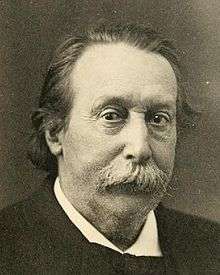Eduard Hagenbach-Bischoff

Eduard Hagenbach-Bischoff (20 February 1833 in Basel – 23 December 1910 in Basel) was a Swiss physicist. The Hagenbach-Bischoff quota (a voting system) is named after him.
The son of the theologian Karl Rudolf Hagenbach, he studied physics and mathematics in Basel (with Rudolf Merian), Berlin (with Heinrich Wilhelm Dove and Heinrich Gustav Magnus), Geneva, Paris (with Jules Célestin Jamin) and obtained his Ph.D. in 1855 at Basel. He taught at the Gewerbeschule (vocational school) in Basel and was after his habilitation, a professor of mathematics at the University of Basel for one year.[1] From 1863 to 1906 he was a full professor of physics at Basel (successor of Gustav Heinrich Wiedemann). In 1874 he became director of the institute of physics at the newly founded “Bernoullianum” in Basel, and from 1874 to 1879 he was president of the Swiss Academy of Sciences.[2]
Hagenbach-Bischoff was involved in the popularisation of science, and at the “Bernoullianum” he gave more than 100 popular talks,[3] such as one in 1896 on the newly discovered X rays.[4]
Notes
- ↑ Biographical information are taken from obituary of Henri Veillon and from History of the physics department of Basel University (pp. 3 and 4).
- ↑ The information on the Swiss Academy of Sciences is contained in the following list of presidents.
- ↑ See Veillon, page 53.
- ↑ See Domman, p. 59 and Figure 24 after p. 447.
References
- Henri Veillon: Worte der Erinnerung an Eduard Hagenbach-Bischoff. Basel, 1911 (Verhandlungen der Naturforschenden Gesellschaft in Basel. Bd. XXII), pp. 46–53 (online).
- Friedrich Zschokke: Professor Eduard Hagenbach-Bischoff in: Basler Jahrbuch. 1912, pp. 146–191
- Monika Dommann: Durchsicht, Einsicht, Vorsicht. Eine Geschichte der Röntgenstrahlen 1896–1963. Chronos, Zürich, 2003 (PDF; 3,3 MB).
External links
- Hagenbach, Eduard in German, French and Italian in the online Historical Dictionary of Switzerland.
- History of the physics department of Basel University